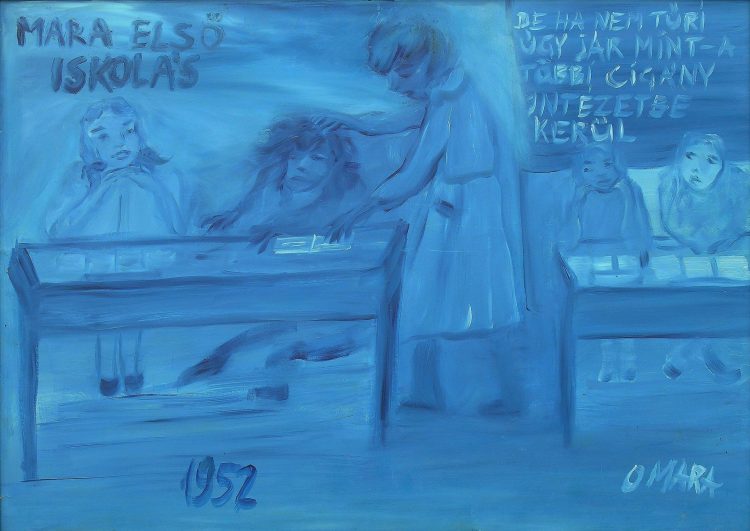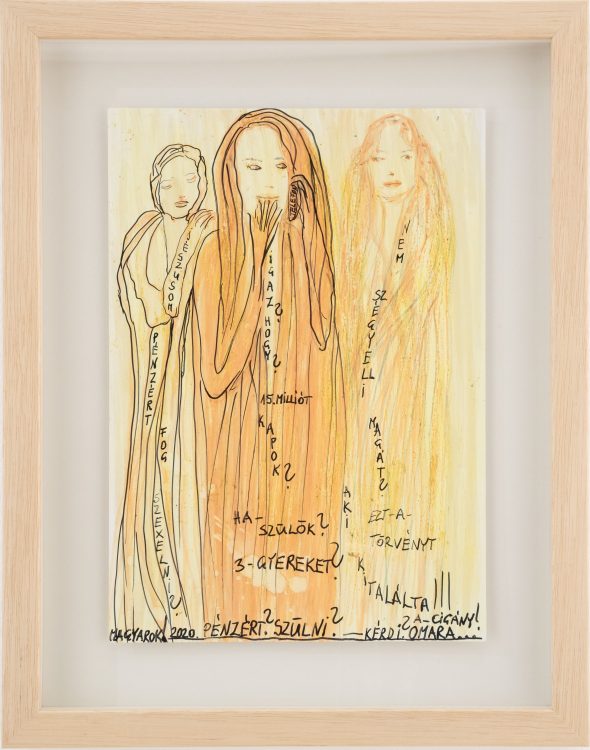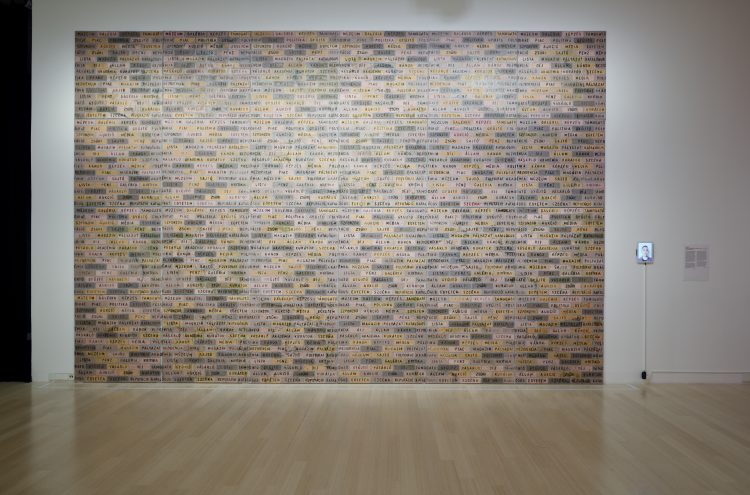Intersectional Dimensions of Care. Curatorial Considerations around the Exhibition ‘Handle with Care’

Oláh Mara OMARA Mara in First Grade (1952), 1998, oil on fibreboard, Ludwig Museum – Museum of Contemporary Art “But if she doesn’t tolerate it, she’ll end up in a reform school, like other gipsy kids.”
Care permeates almost every aspect of our social reality. It is partly in the wake of the COVID-19 pandemic that both collective and individual care has been brought into sharper focus than ever before. The global pandemic has shed light on the politics of care and has shown the heavy burden on women, social workers, vulnerable groups, and the inequality in the gender distribution of caring work. It has also highlighted issues relating to the state’s role, the primacy of economic interests, and the limited autonomy of the individual.
The exhibition Handle with Care – held at the Ludwig Museum Budapest – and its title referred to the vulnerability of those in need of care, the asymmetrical relationship between carer and cared for, the fragility of life and our ecosystem, and the cracks and gaps in the social care system, but most of all, it calls attention to the need for collective responsibility. The exhibition sought to raise questions about the social role of the museum, which, beyond the careful handling of artworks, faces new tasks and challenges that affect society. How can an art institution become more sensitive to social issues, more inclusive, more open, more accessible, in short, a more relevant place?
The starting point for the exhibition was the fragile situation of caregivers, invisible workers, and marginalized communities. They are the ones who are excluded from cultural spaces on multiple levels, both because their problems are barely visible and because of the physical, material, and “mental” barriers. Care and caring activities are historically, socially, and culturally closely linked to women and mothers’ roles. However, there is an intersectional dimension of care, the complex interplay of multiple, cumulative discriminations. The care crisis particularly affects Roma women, mothers, caregivers, and children alike, given that they are among the most vulnerable groups and the targets of most human rights violations. With an attempt to apply an intersectional lens, the exhibition Handle with Care aimed to reflect on the unequal representation of marginalized communities in cultural institutions, to give visibility to the multiple disadvantages and the presence of power relations in the institutional care system.
Looking at the Ludwig Museum’s collection, one can detect a lack of artists from underrepresented ethnic backgrounds. Beyond the fact that in 2012, the museum purchased eight paintings from Oláh Mara OMARA’s (1945–2020) renowned blue series, the representation of marginal positions has not become part of the museum’s acquisition policy ever since. The institution also owes the processing and a comprehensive presentation of the artist’s oeuvre. In the awareness of this deficiency in the exhibition Handle with Care, the works of OMARA are presented in a privileged manner alongside a discursive program. OMARA’s large number of paintings (9 in all, borrowed from different collections) within the exhibition was installed strategically, not in chronological order nor in a cluster-like hanging but presented as mise en abîme (exhibition within an exhibition), inserted in different sections of the show to reflect on the intersectional dimensions of care.

Works by Kateryna Lysovenko, Oláh Mara OMARA and Oksana Briukhovetska. Installation view, Handle with Care, Ludwig Museum – Museum of Contemporary Art. Photo: József Rosta
fig.1
In the global art scene, the position of ethnic Roma artists is complicated, with an accompanying risk that their ethnic background is being used or exploited by leading institutions and high-profile recurring exhibitions in the name of “inclusion” and “diversity”. Giving Roma art adequate attention, equal treatment, and positioning artists of Roma origin in appropriate exhibition contexts has the potential to challenge cultural hegemony, highlighting structural inequalities and unveiling intersectional discrimination on all levels of art and society. This was the idea behind the group exhibition Handle with Care, which tried to step out from the white cube representation format by extending to off-sites (RomaMoMA Nomadic Library feat. Romani Design) and experimenting with different formats of knowledge production (Active Thinking Workshops by Norbert Oláh and Andrea Pócsik).
Intervention in the museum’s library
As a conceptual, site-specific extension to the exhibition Handle with Care, an intervention was realized in the museum’s public library. Hosting RomaMoMA Nomadic Library and inviting Romani Design to collaborate, the library was transformed into a gathering space for collective learning. RomaMoMA Nomadic Library, built by ERIAC, critically reflects the white, Western-dominated art historical and cultural canon by expanding it with post-colonial theoretical perspectives. Romani Design Fashion Studio (founded by Erika Varga and Helena Varga) declared its mission to build socio-cultural prestige for the Roma community through fashion and design. In the form of a bookshelf, a ladder installation was created in the spirit of functionality, adaptability, and activism. The ladder symbolizes progress and efficient work, and it is a bridge, a connecting point among the fragmented communities. The existing furniture of the library was complemented with tablecloths, pillows, and assemblages, but not as decorative elements of a traditional Roma interior, but as carriers of strong messages and statements (#activism #representation #collective care).

RomaMoMA Nomadic Library feat. Romani Design. Library, Ludwig Museum – Museum of Contemporary Art. Photo: Zsófia Szabó.
fig.2.
Six large-scale assemblage textile paintings were created as well using handmade patchwork techniques, which include the international Romani anthem “Gelem Gelem” in Hungarian language, portraits of outstanding Roma intellectuals, and excerpts from the animated series entitled Cigánymesék (Gypsy tales) by Kecskemétfilm. During the four months of the exhibition, the library served as an open space, an agora, where people with different backgrounds and ages could connect, exchange, and reflect on the exhibition (from participants of academic seminars and visitors of the museum to social workers, peers, and volunteers).
Active Thinking Workshops
The library hosted an educational and community outreach program series led by artist Oláh Norbert and cultural researcher Andrea Pócsik called Active Thinking Workshops. Commissioned by the curators, four events were organized around the topics of representation, ethnicity, women’s rights, and segregation with active involvement of the audience and activation of the RomaMoMa Nomadic Library. Oláh and Pócsik took on the role of mediators by initiating discussions and creative production using the exhibition as a resource, as a knowledge-producing site. In the final session, the notion of CARE was interpreted as the ability to stand up for others. Oláh and Pócsik involved peers and volunteers from the civil organization From Streets to Homes Association, themselves refugees from Ukraine, to speak about personal experiences and reflect on the exhibited works. As Iliana Fokianaki emphasized in her opening speech to the exhibition Handle with Care: “Collective care demands the sharing of power. Stepping aside and giving the floor (and our power) to others is an act of collective care. Sharing power is another. “[I]

Active Thinking Workshops by Norbert Oláh and Andrea Pócsik. December 2023, Library, Ludwig Museum – Museum of Contemporary Art.
fig.3.
Norbert Oláh, an artist of Roma origin, was present in a double role. Besides being one of the leaders of the discursive program, he was also an exhibiting artist. As part of the core curatorial approach, the works were not selected by “curator’s choice” but in a process of active dialogue with the participating artists, in several cases resulting in new commissions. During this process, Oláh formulated clear conditions to avoid being the “token Roma” in the exhibition. Instead of bringing up a “Roma issue,” he proposed a topic that is barely addressed in the Eastern European art scene, namely the carelessness and precarious structure of the art field itself. His monumental painting created for the show, The Anxious Field of Art (2023), resembles a brick wall, which is a recurring symbol in his artistic practice. This time, it can be read as his breakthrough of the walls of the museum, and in a small-scale video accompanying the painting, the artist uses his first entry to encourage his fellow artists by wishing good luck, a gesture of care and collegiality in the field of art.
fig.4.
OMARA and the politics of care
Omara – from being a cleaning lady to a contemporary artist – experienced for herself the discriminatory treatment of the institutions of care, mainly of the male representatives (doctors, policemen, a school director, teachers, the mayor, and a councilor). The notions of care and non-care influenced and determined her whole life from early childhood till her sudden death in a hospital in 2020. Poverty, poor living and working conditions, and the struggle for fair housing are recurring themes in her paintings.
fig.5.
Besides a set of multiple exclusions (economic, age-related, racial, and gender) the idea of the “communal forms of living” is expressed in the painting Guesthouse for Gypsy Women on Small Pensions, 2007. This time, she does not criticize the shortcomings of the pension system but envisages collective housing based upon “solidarity contracts” as a solution for old age poverty, which bears a woman’s face. Omara’s utopian vision, which is not based on private poverty, but on the common idea of collective care practices is a strong statement in contemporary Hungary, where the pension minimum is still 28 500 HUF (ca. 70 Euro).

Oláh Mara OMARA
Guesthouse for Gypsy Women with a Small Pension (2003), 2007, 2010, oil on fibreboard, Courtesy of Everybody Needs Art & Longtermhandstand, Budapest
“Now in 2007, there are even more vulnerable people… I don’t understand why they don’t follow my idea. They could live like ladies if 10 of them moved in together at least for the winter.
Only non-gypsy women checked in, so I was accused of racism. It was proved that gypsies grow old in families. Or they won’t even reach retirement age.”
Now in 2010, I finally decided not to die until I establish this free pension in my luxury shack in Szarvasgede…
2003. OMARA”
fig.6.
Motherhood was a determining, life-changing experience for her as she obsessively painted hundreds of portraits and often intimate stories from her daughter’s private life. In the painting Giving Birth, 1967 (a loan from The Museum of Ethnography), her birth is transformed into a transcendental Holy Family scene with the inscription “My only diamond, God fulfilled my desire”. The female figure (Holy Mary) dominates the composition, sitting in a birthing chair while receiving the long-awaited infant, and the doctor wearing a mask (Joseph) is just assisting in the background. In the conservative climate of contemporary Hungary, Roma women appear in public discourses as giving birth to too many children to access social benefits related to childrearing. Framing Roma mothers as irresponsible persons has been central in constructing Roma as “others” and as undeserving citizens. In the official political rhetoric, women’s labour and care work has been sentimentalized, and pro-natalist policies of the current carefare regime exclude the most vulnerable groups. [ii]
Omara’s paintings frequently comment on the discrimination of Roma mothers and caregivers, on the growing inequalities and social disintegration of Hungarian society. In one of her last drawings, To Give Birth for Money? (2020) Omara expresses her indignation about the state measures on reproduction, namely the government’s family housing benefit (called CSOK).

Oláh Mara OMARA
To Give Birth for Money?, 2020, oil on fibreboard, Courtesy of Everybody Needs Art & Longtermhandstand, Budapest
“Jesus, are you going to have sex for money? Is it true that I will get 15 million if I give birth to 3 children? Isn’t the one who invented this law ashamed of himself? The gypsy Omara is asking this… Hungarians! To give birth for money?”
fig.7.
Institutional discrimination is examined in the context of school segregation. In her painting Mara in First Grade, 1952 (1998), we see physical abuse and verbal aggression by the teacher as early as the first grade of elementary school. Considering this early negative experience of the education system, the painting Nursery School, 1971 (1998), where her daughter is the victim, is much more shocking. In this picture, the mother’s guilt emerges as well: she leaves her little daughter in a prison-like institution, even though she knows she will be mistreated.

Oláh Mara OMARA
Mara in First Grade (1952), 1998, oil on fibreboard, Ludwig Museum – Museum of Contemporary Art
“But if she doesn’t tolerate it, she’ll end up in a reform school, like other gipsy kids.”
fig.8.
Resistance is often discussed concerning her artistic practice[iii], as she rebelled against and resisted dominant power structures. I argue here that the politics of care is an equally dominant concept for understanding OMARA’s outstanding work of art. Nevertheless, being a “subaltern” herself, she was concerned about those who lacked care (e.g., gypsy mothers, juvenile prisoners, retired women), using art as a tool to strengthen solidarity and propose better, often utopian solutions to repair our unequally divided world.
Handle with Care
Ludwig Museum – Museum of Contemporary Art, Budapest
15.09.2023—14.01.2024
Concept: Viktória Popovics
Curators: Rita Dabi-Farkas, Viktória Popovics
Exhibiting Artists: BAGLYAS Erika, Maria BARTUSZOVÁ, Oksana BRIUKHOVETSKA, Elina BROTHERUS, Seba CALFUQUEO, Alexandr CHEKMENEV, Phil COLLINS, Anna DAUČÍKOVÁ, EPERJESI Ágnes, ESTERHÁZY Marcell, FAJGERNÉ DUDÁS Andrea, FÁTYOL Viola, Andreas FOGARASI, Coco FUSCO, Anna HULAČOVÁ, Sanja IVEKOVIĆ, KIS Judit, LŐRINCZ Réka, Kateryna LYSOVENKO, MATERNAL FANTASIES, OLÁH Norbert, Oláh Mara OMARA, Kateřina ŠEDÁ, SZÁSZ Lilla, SZENES Zsuzsa, TARR Hajnalka, TRANKER Kata, VÉKONY Dorottya, Stephanie WINTER.
External Location: KASZÁS Tamás, LÓRÁNT Anikó
Contributors: RomaMoMA Nomadic Library feat. Romani Design
[i] Kollektív gondoskodás – Ludwig Múzeum Blog
[ii] In Conversation with Eva Fodor: How the Carefare Gender Regime Shapes Hungary | Review of Democracy (ceu.edu)
This text is co-financed by the Governments of Czechia, Hungary, Poland and Slovakia through Visegrad Grants from the International Visegrad Fund. The mission of the fund is to advance ideas for sustainable regional cooperation in Central Europe.





Leave a Reply